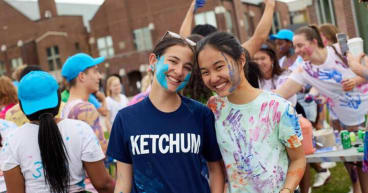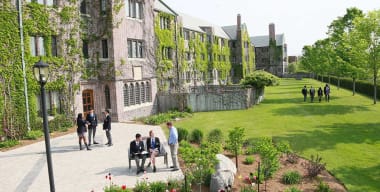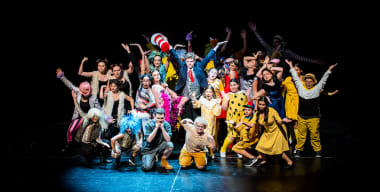Not a break from learning, but a continuation of it.
Parents rightly frown on those motives despite the fact that, even then, the time away from school can prove useful and motivating. If a student truly doesn’t know what he or she would like to study after high school, then taking the time to consider options is far better for all involved than simply enrolling at university as the default. Given the costs of tuition, as well as academic competition, university is not the place to be finding yourself or trying new interests on for size, something that the stats demonstrate. Each year 38% of students drop out of university or change majors, delaying or obviating graduation. That’s a big number. It’s easy to wonder if it would be as high if more students saw a gap year as a viable option. It might delay graduation by a year, though not always. In some cases, it could mean the difference between completing a university degree and, well, not.
That said, the best use of a gap year is one that isn’t just a break, but augments the student's high school career. Princeton University describes its program as a “bridge year,” this to highlight the continuum of a student’s intellectual and academic path. Some schools in Canada offer bridge programs, though they don’t always deploy the term in the same way; bridging programs at York University, for example, are designed to prepare students for success at university, such as mature students, international students, or those arriving from community college. The University of Alberta uses the term specifically in reference to international students, where their bridging program intends to build the requisite language skills in students for who English is a second language.
The best case
Whatever term we use, the best gap year plan is one that puts parents and university admissions officers' minds at ease. This would be it: a student applies for university entrance at the end of high school, gains admission, then requests deferral and submitting a plan for how they intend to spend it. The plan is concrete, listing real plans, and participation in accredited programs that reflect the student’s interests and course of study. Then, the university grants the deferral, and all is well. It’s a common model in Europe, where gap programs began in the 1960s, and is increasingly common in the US. Harvard, for example, suggests that students defer their acceptance for a year in order to gain some real-world experience. The Yale University office of carreer strategy notes that "short-term experiences can help students explore career paths and gain experience and credentials." They also outline some of the things they feel make for a productive use of the time.
All of that is an indication of how central the gap year experience is becoming to student success in North America. While deferring university entrance is less common in Canada than elsewhere, that is changing, too. At many Canadian private schools between 7% and 10% of graduates will defer university acceptances in order to take a gap year.
The next best case
The more common model in Canada at the moment is when a student creates a plan for their gap year, one that is sound, and which allows them to further explore their academic interests. Then they apply to post-secondary programs at the completion of the year.
Not an extended beach vacation, but travel in order to gain a sense of the world and their place within it.
What a university admission officer will want to see is that the time has been used productively, and that students have used it to add value to their application. A well-spent year will be one that has been challenging, allowing students to explore their place in the world, interact authentically with others, and foster academic and social maturity.

Class Afloat - West Island College International
Why it's important
Employers look very favourably on university graduates who have taken a gap year that is relevant to their course of study. It demonstrates self-determination and dedication to the content of their studies, and travel can suggest a real-world experience with international communication. “The biggest problem for student’s post-graduation when they’re applying for jobs,” says Lauren Friese, a career consultant, “is that they all look like clones; there’s not a lot to differentiate business grad one from business grad two, or sociology grad one from sociology grad two. Taking the initiative to work with a charity, or travel the world or whatever it is, those things stand out.”
That said, it's alright to be selfish. Sailing around the world seems like an adventure of a lifetime, and it is. It's also one of those things that, if you don't do it now, you likely never will. When Alexandra Moore heard about the Class Afloat program, she decided to seize the day. Just finishing high school, Alexandra had sailed on a tall ship before and thought that West Island’s program would allow her to see the world.
Jane Ritcey, Alexandra's mother, took a bit of convincing, though now agrees that the expeirence was an important one. “She certainly has a deeper understanding and appreciation of the world,” says Ritcey. “They have seen everything from palaces to poverty.”
While Alexandra had always been independent, according to Ritcey, she’s become even more responsible and team-oriented after her time on the ship, where everybody is expected to pull their weight and watch out for others, both on land and off. During her travels, Alexandra also decided what she wants to do with the next stage of her life.
How to spend a gap year
International volunteer programs
Making money, especially when facing university enrollment, is always a good idea. That said, a gap year spent only making money—taking a local 9 to 5 job doing something unrelated to their future goals, say—isn’t always, or perhaps ever, the best use of the year. It will help with payments, perhaps, but better would be engaging in activities that will help a student gain insight into who they are, what they'd like to persue, and help build their resume toward that end. Volunteering abroad meets all of those goals and then some, often at low cost to the student, which is why it has long been the most popular gap-year activity.
The volunteering options are vast, as are the means of acquiring them. Some organizations recruit international volunteers in Canada, while others are organized once a student arrives in the destination country. ECO Volunteer UP, for example, offers programs in Ecuador, ranging from working with street children in Quito, or travelling to the countryside to work in a farming community. Travel to and from Ecuador isn’t covered, and there is a fee for administration, but otherwise room and board and local transportation are provided.
Domestic volunteer programs
Staying in Canada for a volunteer placement may not sound as exotic as going to Africa or Ecuador, though it can be just as rewarding, if not more so. Because it is within a student’s home country, it can also be more meaningful, and lead more readily to connections within a career path later on.
Cultural immersion programs
There can be quite a bit of grey area between volunteering and cultural immersion programs, so much so that it’s perhaps all grey area. Volunteer Nepal, for example, places volunteers within poverty stricken communities, helping with daily life and the administration of health care. Getting to Nepal is a journey unto itself, and the experience wtihin the community is a great entrée into issues of population health. The program is augmented by living within the community, we well as trekking and rafting trips, among other things, to allow a bit of fun while interacting with like-minded peers from around the world.
Not a tour of museums and cathedrals, but opportunities to engage with others, authentically experiencing the challenges of international communication.
Academic programs
Just as there can be significant grey area between volunteer and culture programs, so too between academic and non-academic programs. The term post-graduate year is primarily used in reference to academic programs, such as that offered at Ridley College in Ontario. Commonly known as the “victory lap,” a post-graduate year is a fifth year of high school courses, intended to take courses and raise marks in order to strengthen a university application. Robert Land Academy offers a similar option, if in a more ordered setting.
Gap years, in contrast, are more typically chosen in order to get away from classroom academics, and to gain experience prior to entering university, though some programs offer a little bit of both. Class Afloat, for example, accepts graduates on board their sailing programs, though all participants also enroll in courses for credit.
Language immersion programs
Fulford Academy in Brockville, Ontario offers international students a gap year program to master their English skills before moving on to a North American boarding school or university. Students work on mastering English through English fundamentals and credit support classes. Fulford Academy also prepares its students for life in Canada with frequent evening and weekend excursions. “It’s not just an ESL curriculum; they focus on the cultural integration, too,” says Anna Galanta, admissions director at Appleby College in Oakville, Ontario. “The Fulford grads are well-prepared when they get here.”
Similarly there are French language programs that, as with the English counterparts, offer full linguistic and cultural immersion. The benefits can be utilitarian, such as preparing for study in a French-language environment, as well as personal, affording insight into the linguistic and cultural diversity of the nation. Some, such as the YMCA International Language School Gap Year Program run out of LaSalle College in Montreal, attracts participants from across Canada around the world, allowing for a strikingly international experience.
Resources and programs:
Canada World Youth
World University Service of Canada
Education First
CUSO International
My Gap Year
Study and Go Abroad
Global Leadership Academy
Thinking Beyond Borders
Projects Abroad
World University Service of Canada
Gap Work
•









